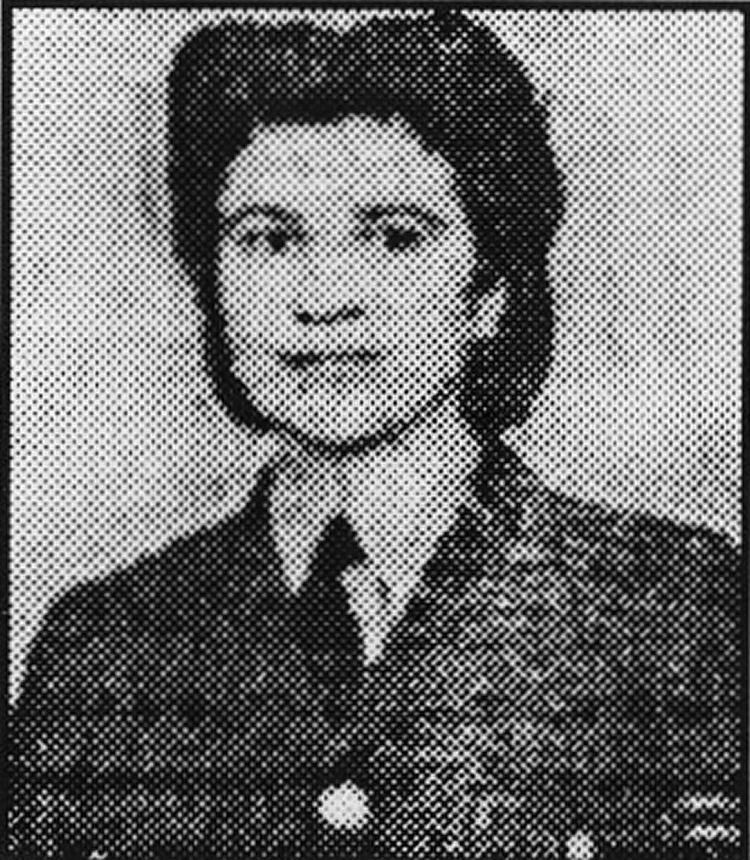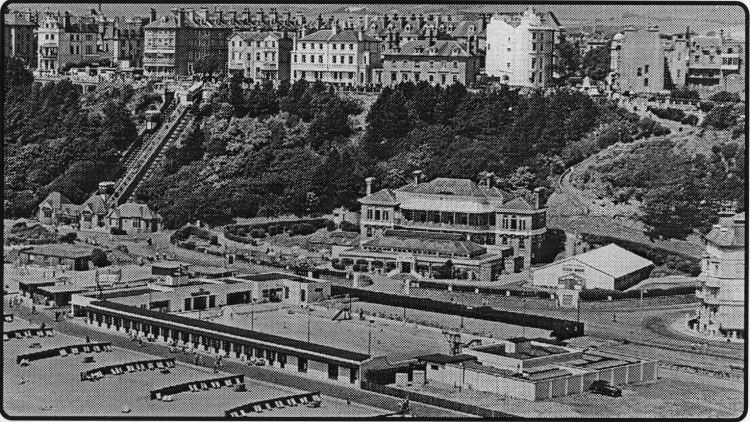
Published 17 April 2003


LEFT: From Folkestone Herald files, a photograph of Claudia Calmon, a
little known wartime hero. See story below. BELOW: The old Folkestone Marina
and the once popular outdoor swimming pool with the cliff lifts in the
background
- another old photograph from the files of the Folkestone Herald.
TWENTY-five years ago aviation historian Roy Humphreys, of Hawkinge, was
writing in the Herald about a secret service base at Capel during the Second
World War.
He told how Claudia Calmon, a refugee from her homeland of Czechoslovakia,
joined the WAAF and was then recruited for more covert operations,
operating1 from the striking white, cliff-top property at Capel, known as
London House.
A keen horsewoman, Claudia had been all set to become an officer in the WAAF
and was initially due to become a translator but, being fluent in four
European languages, including German, it is hardly surprising she was
invited to train for more undercover work.
She joined the Political Intelligence Department (P.I.D.) at Woburn Abbey.
Subsequently Claudia trained with the crypto-analysis section at the
headquarters of operational intelligence at West Kingsdown, near Wrotham.
Classified as a signal linguist, she was taught wireless telegraphy,
operational code systems and had a thorough grounding in known German radio
frequencies.
On completion of training, in February 1943, she was given the choice of
working at Montrose, Swanage, Gorlestone, Eastbourne or Capel-le-Ferne.
Claudia chose Capel, which came within
No. 11 Group of Fighter Command, because of its proximity to London - where
her parents lived - but also because it offered intense action.
It was over this area that the German Luftwaffe concentrated its menacing
bomber formations.
Fighters and fighter-bombers also took the shortest sea crossing as they
went about their attacks on Kent and its airfields and other sensitive
areas, such as local radar stations.
In the secret “Y” Service monitoring unit at Capel her job was to tune into
enemy radio frequencies to gather intelligence.
During the Battle of Britain and the Blitz that followed, “Y” Section at
Capel naturely became directly linked with the nearest RAF fighter station -
Hawkinge.
Seaplane shot down
One of the earliest recorded successes in which Capel and Hawkinge were
involved, was the shooting down of a German HE 50 seaplane near Dungeness by
a young pilot from the local airfield.
These sometimes carried red crosses to denote they were on missions of mercy
to pick up airmen brought down in the sea, but also carried out spying and
other covert missions, bringing an airmen’s code of honour into disrepute,
so it was not surprising our airmen attacked them.
Fighter action was apt to be fast and furi-
ous and the whole operation, from beginning to end, might take only 14
minutes.
“Y” Section, Capel, became an integral part of the defence structure of
Fighter Command. It was, wrote Roy Humphreys, a thorn in the side of the
Luftwaffe.
And it certainly didn’t go down well in the German air force to discover the
whole of “Y” Section was manned by women!
The perhaps naive (or was it arrogant?) German pilots could be careless
about security when in action, talking among themselves about their wives
and sweethearts, about forthcoming leave, or about other unit personnel.
They even discussed methods of attack upon unsuspecting British pilots,
during operations.
All this seemingly useless information could be used by the British
intelligence
service, and was recorded in laborious long-hand by the women operators.
And, in one documented case at least, it was to save a Hawkinge pilot’s
life.
Roy Humphreys describes how Claudia picked up conversation between two
pilots calmly discussing how best to carry out an attack on an unsuspecting
‘Jim Crow’ pilot operating from Hawkinge.
Life-saver
In seconds she had translated their chatter passed on the vital information
and the British pilot quickly received the urgent message “Break! ....
Break!” in his earphones in time to take evasive action.
Claudia lived in a billet in Folkestone and, after marriage stayed in the
district, but wrote Roy, she preferred to keep her identity a secret.
Life saver
)
 |
Tragedy narrowly averted as new lifeboat launched
•4 q/\qFOLKESTONE'S new lifeboat "Leslie" •L9UOwas launched to the sound
of a cannon being fired in “half a gale' from the west. This was
mistaken for a fire alarm signal which sent people hurrying towards
Dover Road anticipating that there was a serious fire, but a rush of
fishermen to man the vessel for the first time allayed those fears. The
new boat was a ton lighter and three foot shorter than its predecessor,
the: "John McConnell Hussey," and had a centre keel. The event was not
without incident, a young fisher lad narrowly escaping serious injury
running up the slipway directly in the path of the rocket apparatus
which was about to be fired as part of the practice launch. Happily, he
heeded a warning and dropped to his knees, otherwise he could nave taken
the full discharge of the rocket. MP Sir Edward Sassoon presented a
billiard table to Hythe Working Men's Club, from his own home, with the
distinction of having been played on by King Edward VII. His attendance
at the Club to hand over the table in person was much appreciated by
members, especially when he proceeded to engage the Mayor Hythe in a
game at the table.
|
Jubilation as Venetian Fete saved by appeal
QCqTHERE was jubilation in Hythe that a _L«/Oopublic appeal had
guaranteed that the annual attraction of the Venetian Fete would once
again be held on the Royal Military Canal in August, thanks to a
newly-financed reserve fund. The organisers had been forced to seek a
financial guarantee that they would not have to foot the bill should bad
weather send the venture into the red. The fete organiser and secretary
were to be paid in future. The 375th anniversary of the birth of famous
Kent physician Dr William Harvey was commemorated at the Leas Cliff
Hall, when wreaths were laid at memorial on the Leas, the Bishop of
Colchester suggested a pilgrimage should be made to Essex. The Centenary
of Shorndiffe Garrison Church was celebrated with a special service
attended by the local mayors, the band of the Royal Inniskiiling
Fusiliers playing, and there was a procession with palm branches. New
Romney was looking to the Mothers' Union to repair the town's civic
flag, left badly damaged in a strong wind while flown at half-mast. Half
the mayor's crest on the old flag had : been destroyed and there were
doubts whether it could be repaired economically otherwise.
|
Tributes paid to local Cinque Ports Flying Club events
1 QOQ^ EASTER Hockey Festival was a JL«7^0treat for Folkestone fans who
saw England trounce France 12-0 and a Hockey Association XI beat Belgium
6 0, but the All-India Olympic squad beat allcomers to firmly establish
themselves as favourites for the Olympic Games hockey tournament. Other
visiting teams included players from Spain and Germany. Sir Montagu de
P. Webb, CBE, President of the Air League of India and vice-president of
the Cinque Ports Flying Club praised the "patriotic and public spirited
men of Kent" who worked hard to increase the popularity of aviation and
the number of machines and pilots available for defence of the UK in
times of emergency. Speaking at a two-day flying club meeting he told
how Britain had fallen behind Continental competitors since the First
World War in both military and civil air services, and how important it
was to build up a strong potential reserve of airmen ready to come to
the aid of the nation in time of conflict. Writer Felix told of a rare
town guide, which told how, in 1661 trawling was banned before March 12.
|
Young linguist to rescue in school’s Pinocchioshm
Q^QYOUNG Alan Lowrey, aged 13, l Oproved a great asset to his school
when it was decided by Dover College Junior School to stage a production
of Pinocchio. Fluent in Italian he was able to assist headmaster Richard
Rottenbury in the translation of the script from Italian to get over
copyright restrictions. Folkestone Amusement Association Fund financed a
new memorial plaque in Folkestone to Dr William Harvey^ There was some
disappointment that the Post Office failed to mark the 400th anniversary
by issuing a commemorative stamp. Folkestone soccer manager Brian Yeo
wasn't too happy at the prospect of losing player Neil Cuglev, signed up
by Margate, but his place in: the local squad was promptly filled by
John Keirs, from Maidstone. A local bov of 14 fell from a train on the
Romney, Hythe and Dymchurch Light Railway and broke his leg at Carey's
Bridge. Red Tape was blamed for delays holding up construction of a new
access road to Park Farm industrial estate. It meant schoolchildren
having to run the gauntlet of heavy traffic, perhaps for several months.
It was only an extension of Park Farm Road but it required planning
consent before A20 alterations..... |
|



